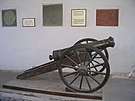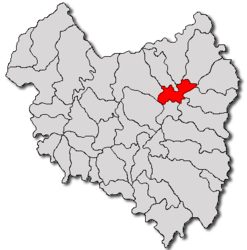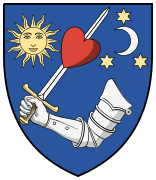Târgu Secuiesc
Târgu Secuiesc (Romanian pronunciation: [ˌtɨrɡu sekuˈjesk]; Hungarian: Kézdivásárhely, Hungarian pronunciation: [ˈkeːzdivaːʃaːrhɛj] (![]()
Târgu Secuiesc Kézdivásárhely | |
|---|---|
.jpg)  Descending, from top: Centre of Târgu Secuiesc, Concert Hall, Houses, Statue of Áron Gábor, Reformed church, A cannon belonging to Áron Gábor | |
 Flag  Coat of arms | |
 Location in Covasna County | |
 Târgu Secuiesc Location in Romania | |
| Coordinates: 45°59′49″N 26°8′26″E | |
| Country | |
| County | Covasna |
| Government | |
| • Mayor | Tibor Bokor[1] (UDMR) |
| Population (2011)[2] | 18,491 |
| Time zone | EET/EEST (UTC+2/+3) |
| Vehicle reg. | CV |
History
The town was first mentioned in 1407 as Torjawasara, meaning in Hungarian “Torja Market”. (Torja is the name of a stream nearby and is also the Hungarian name of the nearby village Turia.) Originally, the Hungarian name Kézdivásárhely was also used in Romanian in the form Chezdi-Oșorheiu, but this was altered to Tîrgu Secuiesc (now spelled Târgu Secuiesc) after the accession to Romania in 1920 under the Treaty of Trianon. The Hungarian native name means “Kézdi Market”, Kézdi being the name of a Székely “seat”, a historical administrative unit. Its status as a market town dates back to the Middle Ages. The city was taken over by Hungary during World War II, following the Second Vienna Award of August, 1940. A small Jewish community was set up in the 1880s; it numbered 66 in 1920. In May 1944, the Hungarian authorities sent its members to the Sfântu Gheorghe ghetto, and deported them to the Auschwitz concentration camp the following month.[3] Sovereignty was restored to Romania following the war.
Demographics
According to the 2011 census, the town had a population of 18,491. Of the residents for whom data were available, 91.1% were Székely Hungarians, 7.2% Romanians, and 1.6% Roma.[4] The historical demographic evolution is as follows:
Demographic change according to census data:

Education
Despite its relatively small size the town has a few notable high schools: Nagy Mózes, Bod Péter, Apor Péter and Gábor Áron, all bearing the names of important Székely historical personalities. Because of this, Târgu Secuiesc is considered the educational center of the north eastern part of the county.
Gallery
- City center
- City center
 Cultural Center
Cultural Center Children inside Sala Polivalenta Sporting Hall
Children inside Sala Polivalenta Sporting Hall- Day of Székely Freedom Celebration
References
- "Results of the 2016 local elections". Central Electoral Bureau. Retrieved 3 April 2020.
- "Populaţia stabilă pe judeţe, municipii, oraşe şi localităti componenete la RPL_2011" (in Romanian). National Institute of Statistics. Retrieved 4 February 2014.
- Shmuel Spector, Geoffrey Wigoder (eds.), The Encyclopedia of Jewish Life Before and During the Holocaust: Seredina-Buda—Z, p. 1290. NYU Press, 2001, ISBN 978-081-4793-78-7
- Tab8. Populaţia stabilă după etnie – judeţe, municipii, oraşe, comune, 2011 census results, Institutul Național de Statistică, accessed 17 February 2020.
External links
| Wikimedia Commons has media related to Târgu Secuiesc. |
- Official site (in Hungarian, Romanian, and English)
- Kézdivásárhely Centrum City Map
- Official site of the Kézdivásárhely Sportclub (KSE) (in Hungarian and English)
- Nagy Mózes High School
- Gábor Aron High School
